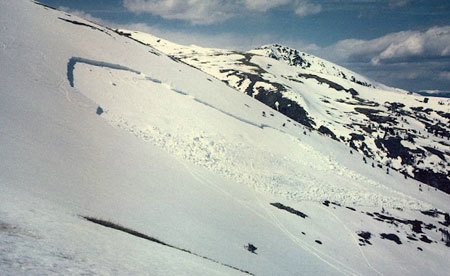An avalanche happens when a layer of snow becomes loose and slides downhill. Thousands of avalanches occur every winter in the mountains and are usually triggered by people. Avalanches are caused by these four factors: a steep slope, a snow cover, a weak layer in the snow cover and a trigger such as a snowboarder or skier.

Avalanches and Snowslides - Three Main Types
- Powder Avalanches - An increasing volume of powdered snow is thrown into the air, charging down the slope like a dense cloud. It can reach speeds of 250 mph (400 kph) and can flatten anything in its path.
- Wet Snow Avalanches - When the temperature warms up, snow weakens and a wet snow avalanche can happen. The snow spreads as it slowly slides. Once it stops, it settles like concrete so buried victims can't move or breathe.
- Slab Avalanches - These are the most common and are usually triggered by skiers. When layers of snow don't cling together, a trigger such as the weight and tracks of a skier or snowboarder, will cause the top layer to slide. There is little chance of escaping the moving slab as it breaks and carries a victim down the slope.
 Avalanche formation
Avalanche formation
Avalanches and Snowslides - Outrunning a Slide
Don't bother trying to outrun an avalanche. You won't make it. Dry slab avalanches usually cruise down a slope around 60-80 mph (97-130 kph.) They can reach these speeds about five seconds after they fracture. Wet avalanches are much slower at about 20 mph (32 kph) but it's still a miracle to outrun one.
The Most Dangerous Avalanche
The most dangerous is a dry slab avalanche - it causes the most deaths. Imagine a dinner plate sliding off a table. When the plate shatters and keeps sliding, the food on the plate hardly stands a chance. The slab shatters like glass with the victim in the middle - escape is rare.
 Slab Avalanche
Slab Avalanche
Avalanche Facts
This usually has a lot to do with luck. But avoiding potential avalanches has to do with using your brains. Here are some avalanche facts to consider:
- Your chances of surviving an avalanche are around 80% if you use/carry the proper equipment (beacons, shovel, probes, etc.).
- Without proper equipment your survival chances are less than three percent.
- Check the conditions and the slope stability before skiing or boarding in avalanche territory.
- Skiing or boarding out of bounds increases your chances of being caught in a snow slide.
- If you're caught in an avalanche, swim with the avalanche to try and stay on top.































